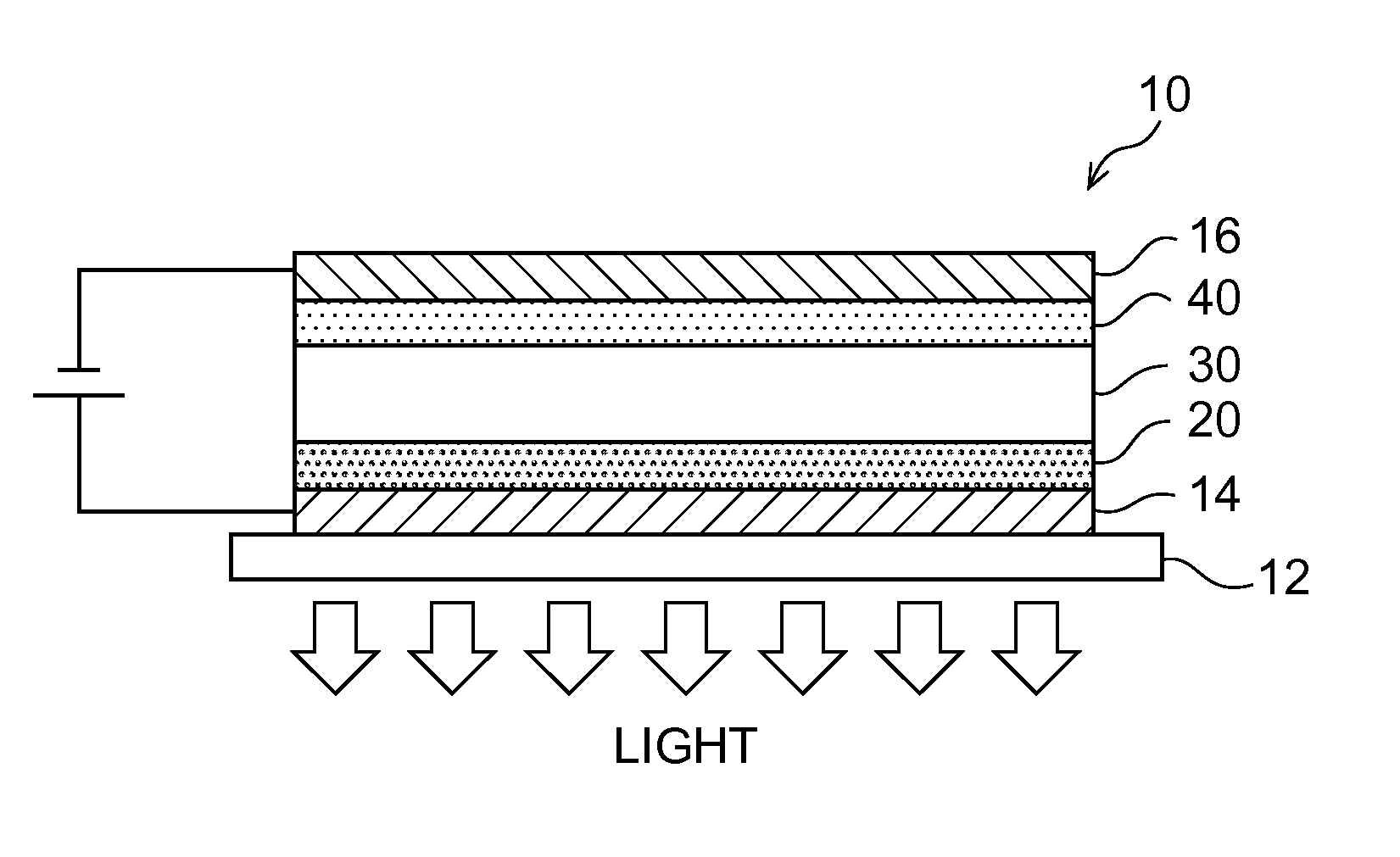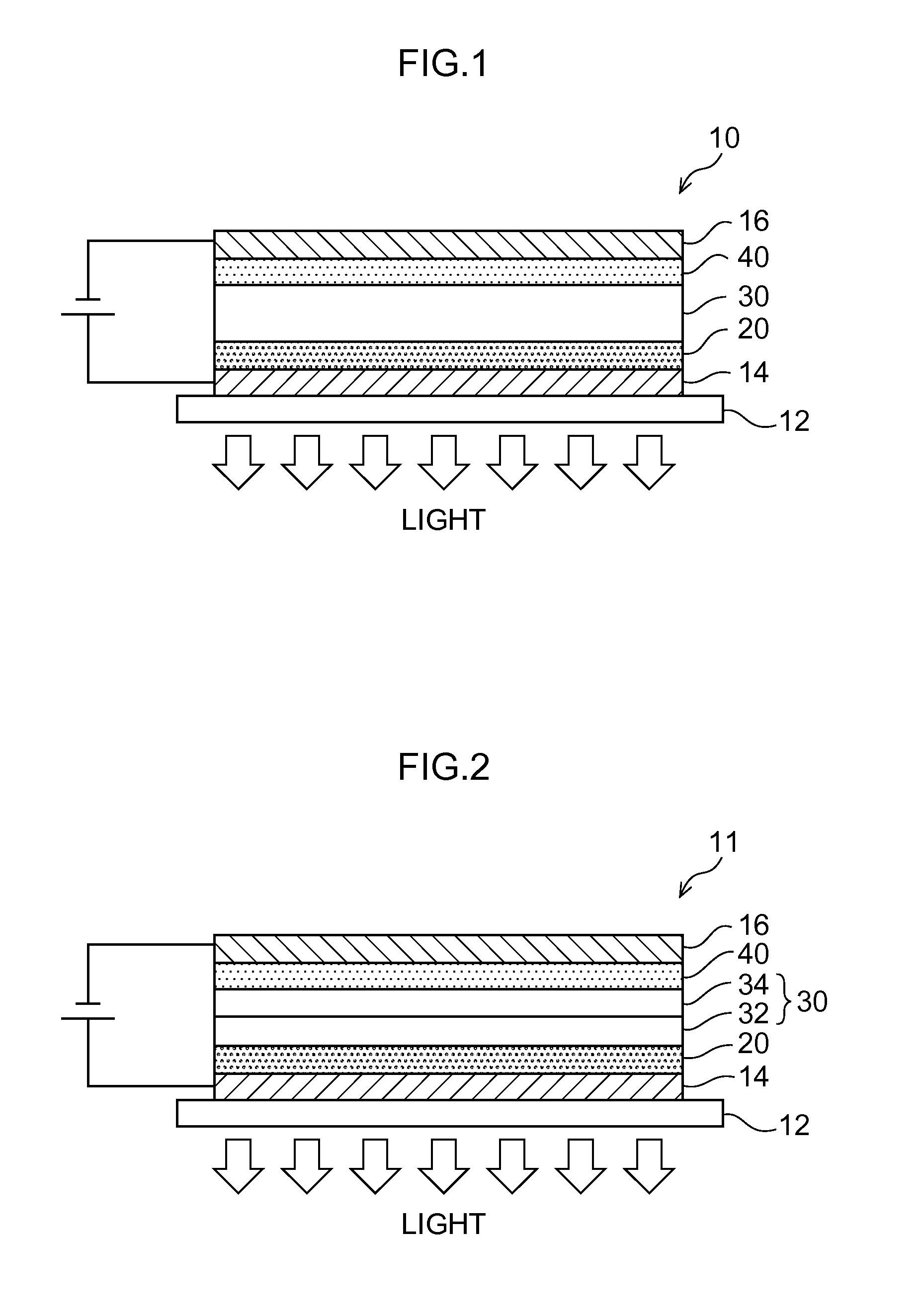Organic electroluminescence device and luminescence apparatus
a luminescence apparatus and electroluminescence technology, applied in the direction of electrical apparatus, thermoelectric device junction materials, semiconductor devices, etc., can solve the problem of excessive energy emitted
- Summary
- Abstract
- Description
- Claims
- Application Information
AI Technical Summary
Benefits of technology
Problems solved by technology
Method used
Image
Examples
first exemplary embodiment
FIG. 1 schematically shows an exemplary structure of the organic EL device according to the invention (first exemplary embodiment). Organic EL device according to the present exemplary embodiment 10 is formed on support substrate 12, and includes a pair of electrodes 14 and 16 located to face each other and an organic layer (including hole-transporting layer 20, luminescent layer 30 and electron-transporting layer 40) located between electrodes 14 and 16.
In the following explanations, an anode is formed on support substrate 12 as lower electrode 14, but it is also possible to form a cathode on support substrate 12 as lower electrode 14.
—Luminescent Layer—
Luminescent layer 30 has a function of receiving holes from the anode, the hole injection-layer or the hole-transporting layer, while receiving electrons from the cathode, the electron-injection layer or the electron-transporting layer, and providing a place at which the holes and the electrons are re-combined to emit light.
The orga...
second exemplary embodiment
FIG. 2 shows a schematic view of a further exemplary embodiment of the organic EL device according to the invention (second exemplary embodiment). Organic EL device 11 according to this exemplary embodiment includes, as luminescent layer 30, two luminescent layers positioned adjacent to each other (first luminescent layers 32 and second luminescent layer 34). In this case, at least one of the luminescent layers includes two or more kinds of phosphorescent material having different T1 values, a binder material, and a charge-transporting material, and has a luminescence spectrum having a peak length based on each of the two or more phosphorescent materials.
The phosphorescent materials included in respective luminescent layers 32 and 34 may be selected according to usage or the like. For example, in order to emit white light by mixing the colors of RGB, it is preferred that the first luminescent layer includes a blue phosphorescent material having a luminescence peak in a range of from...
example 1
An organic EL device having the above standard structure was prepared. The structure of the luminescent layer was as follows.
Luminescent layer: H-4+25%A-1+15%B-1+5%G-1+1%R-1 (30 nm)
The organic EL device was allowed to emit light upon application of a direct voltage using a source measure unit (product type: 2400, manufactured by Toyo Corporation), and the luminance thereof was measured using a measurement device (product type: BM-8, manufactured by Topcon Corporation). The luminescence spectrum and the wavelength were measured using a spectrum analyzer (product type: PMA-11, manufactured by Hamamatsu Photonics K.K.)
The chromaticity based on the CIE 1931 chromaticity coordinate was (x, y)=(0.31, 0.36). The luminescence intensity ratio at luminescence peaks of 456 nm, 503 nm and 620 nm was 0.72:1:0.79, and the color of emitted light in total was white.
PUM
| Property | Measurement | Unit |
|---|---|---|
| triplet energy level | aaaaa | aaaaa |
| luminescence peak wavelength | aaaaa | aaaaa |
| ionization potential | aaaaa | aaaaa |
Abstract
Description
Claims
Application Information
 Login to View More
Login to View More - R&D
- Intellectual Property
- Life Sciences
- Materials
- Tech Scout
- Unparalleled Data Quality
- Higher Quality Content
- 60% Fewer Hallucinations
Browse by: Latest US Patents, China's latest patents, Technical Efficacy Thesaurus, Application Domain, Technology Topic, Popular Technical Reports.
© 2025 PatSnap. All rights reserved.Legal|Privacy policy|Modern Slavery Act Transparency Statement|Sitemap|About US| Contact US: help@patsnap.com



